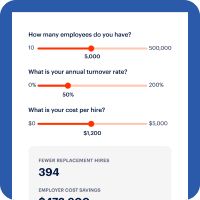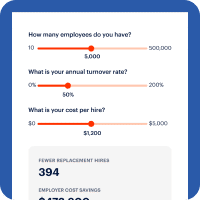Employee turnover or attrition can be expensive for companies. In many industries, the cost of losing quality talent is rising, thanks to increasingly competitive labor markets.
“Retention rate” and “turnover rate” are both metrics organizations use to measure aspects of employee stability and movement, but they focus on different aspects of the workforce.
Retention Rate measures the percentage of employees who stay at a company over a specific period of time. It is typically calculated by dividing the number of employees who have stayed with the company over a certain time period by the number of employees at the start of the period, then multiplied by 100.
A high retention rate indicates that many employees are staying with the company, which can signify a positive work environment and effective management practices.
In contrast, turnover rate measures the percentage of employees who leave a company over a specific period of time, whether voluntarily or involuntarily. It is calculated by dividing the number of employees who left the company during a specific period by the average number of employees during the same period, and then multiplying by 100.
A high turnover rate might indicate issues such as dissatisfaction with the workplace, poor job fit, or external factors like competitive job markets.
Understanding both rates can help an organization address workforce management issues, plan for future hiring needs, and improve the overall workplace environment and policies.
This makes measuring employee turnover rates more critical for employers.
You likely have a few questions about employee retention in your industry.
- How much money is high employee turnover costing your business?
- What is the average employee retention rate?
- How does your rate compare?
According to the U.S. Bureau of Labor Statistics, the average employee turnover rate across all industries was 3.5% in February 2024.1
When considering high turnover across your company, the costs may quickly add up and spill over to operational efficiency, customer service and workplace morale.
Which Industries Have the Worst Employee Retention Rates?
Poor compensation and benefits are historically some common reasons for high employee turnover rates, according to a study conducted by Oracle.2 Let’s take a look at some of the industries with the highest turnover rates as of February 2024:3
- Arts, entertainment and recreation: 8.0%
- Leisure and hospitality: 6.3%
- Construction: 4.5%
The higher the turnover in your organization, the more susceptible you are likely to be to increased costs.
The Cost of Turnover
A high turnover rate is costly for businesses. Find your company’s potential cost savings.
FAQs
-
Does My Company Have a Good Employee Retention Rate?
Your company should also focus on how well you maintain employee satisfaction. A good way to measure this is by using eNPS, or Employee Net Promoter Score. If you’re missing the mark with employee retention, how can you improve internally?
-
What Are Some Ways To Prevent Turnover and Promote Employee Retention?
One strategy to improve retention is to evaluate current tactics like recruiting, employee onboarding and overall company culture — which areas can be improved? What can you do to keep your employees engaged and happy?
Employee Recruiting
When you’re going through the interview process, do you sense that a potential candidate is a job hopper? If an employee quits shortly after they’ve been hired, can you gauge if the employee’s expectations about the job were different than reality? If you are forced into firing people because they don’t have the skills to do the job, this, as well as the aforementioned issues, could be a recruiting issue increasing your turnover rate.
Employee Engagement
Creating the right culture backed by growth opportunities and employee support can go a long way to attracting and retaining strong talent. Companies with highly engaged employees experience an 18% decrease in turnover for high-turnover companies and a 43% decrease in turnover for low-turnover companies.4
Employee Training
Training is a great way to show that you are invested in your employees. Training initiatives can range from career development opportunities to financial wellness programs. By showing that you are invested in your employees' professional and personal lives, you are encouraging loyalty and engagement.
Pay Well, or Pay Differently
It’s no secret that many employees look at pay as an indicator of their happiness at work. If an employee feels they’re not getting enough support for financial wellness, they may consider looking for a new job.
By offering flexibility with pay, you are taking a step towards encouraging employee satisfaction and loyalty. If you’re unable to increase pay, there are other ways to make wages more valuable. If you can’t raise salaries, how can you make your pay feel different? Learn how on-demand pay can help reduce turnover and increase employee engagement.
All information herein is for educational purposes only and should not be relied upon for any other use. The information herein does not constitute the rendering of professional advice by DailyPay. DailyPay does not warrant the completeness or accuracy of any information provided to you.
1 https://www.bls.gov/news.release/jolts.t03.htm:DailyPay, 2020
2 https://www.netsuite.com/portal/resource/articles/human-resources/employee-turnover-causes.shtml:DailyPay, 2020
3 https://www.bls.gov/news.release/jolts.t03.htm:DailyPay, 2020
4 https://www.gallup.com/workplace/285674/improve-employee-engagement-workplace.aspx:DailyPay, 2020














